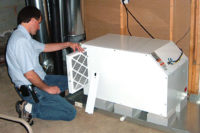Though summer is still a ways away, it’s not too early to prepare. Annual maintenance checks on customers’ air conditioning units are ideal times to discuss reducing relative humidity (RH) in their homes. As you may know, the air conditioner is not the ideal humidity-reducing solution. In most applications, a whole-house dehumidifier solution is best.
In addition to offering increased comfort, installing a whole-house dehumidifier can also help reduce clients’ monthly energy bills. By reducing a home’s indoor moisture while outdoor temperatures are high, occupants will feel cooler and turn their air conditioners down.
Warmer summer air is able to hold more moisture, which is indicated by dew point. High summer temperatures combined with a higher dew point reduces the atmosphere’s ability to evaporate perspiration from the skin, which is necessary for cooling the body, correlating to a higher level of discomfort for clients.
Although a home’s air conditioning system removes moisture while reducing the temperature, the system stops when the desired temperature is met. Humidity remains high in the cooled space, and your client’s humid discomfort remains relatively unchanged. If one were to run the air conditioning unit until desired humidity levels were reached, it would probably feel like they were living in an igloo instead of a home. Only a system dedicated to moisture removal can solve humidity problems — a whole-house dehumidifier.
Any region experiencing a summer dew point average above 55°F could benefit from a whole-house dehumidification system at some point. For example, the average RH in Florida during summer months is 89 percent. We normally think of Florida as more humid than most states, but even in Michigan, the average RH during the summer is 88 percent. Connecticut sees an average RH of 86 percent.
FINDING THE RIGHT RH
For ideal health and comfort, the indoor relative humidity range should be somewhere between 40-60 percent. Outside that range (above or below), conditions can be adversely affected.
Leading literature on allergens recommends keeping RH to less than 51 percent to deter dust mites, since they can thrive at temperatures between 59°-95° and an RH between 55-85 percent.
DEW POINT
Dew point is the atmospheric temperature below which water droplets begin to condense. It varies according to pressure and humidity. The relative humidity is the amount of water vapor present in the air expressed as a ratio compared to saturation at the same temperature.
THE IDEAL COMBINATION
From a human comfort perspective, the worst combination of humidity and dew point is a dew point above 65° combined with a high RH of 70 percent or more. The most comfortable combination is reported to be a dew point of around 55 and an RH of between 40-60 percent.
OTHER REASONS
Summer humidity is not the only reason to install a whole-house dehumidifier. Clothes and bedding might feel moist and sticky; allergy and asthma triggers may intensify because mold and mildew growth has accelerated; and the pest population may increase due to excess moisture that attracts moisture-loving spiders, ants, and other pests. Installing a dehumidifier can reduce annoying musty smells, inhibit mold and mildew growth, prevent corrosion of metal, and prevent wood from warping. A dehumidifier is also used to control unwanted pest populations and excess moisture in crawl spaces. I bet you didn’t know low humidity can extend the life of bug sprays.
Folks living in humid places, like Miami; New Orleans; Houston; Portland, Oregon; or Myrtle Beach, South Carolina, may feel humidity year-round and find great relief by installing a whole-house unit.
WHY WHOLE HOUSE?
Room units generally only treat the space in which they are located, which often requires emptying, cleaning, and other maintenance that whole-house models do not. In addition, they take up valuable living space, are not always attractive, and can be noisy. Even if they are in the basement, homeowners may not wish to run up and down stairs to empty water bins. Whole-house units treat the whole house and often work faster to reach the desired comfort level in the home. With either choice, offering options that work to a homeowner means long-term satisfaction.
As a contractor, you have two interests: assisting homeowners with their IAQ needs and generating income. Installing IAQ products can increase your income, not only through the installation but during maintenance as well. Offering IAQ products while servicing an air conditioner or furnace is just the right thing to do.
Information courtesy of Paige Freeland, marketing manager, General Filters Inc.; Tom Christensen, tech support, General Filters Inc.; and Allan Haybarger, president, CGF Products Inc. For more information, visit www.generalfilters.com.
Publication date: 1/22/2018
Want more HVAC industry news and information? Join The NEWS on Facebook, Twitter, and LinkedIn today!










